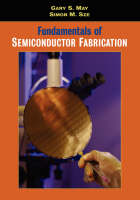Fundamentals of Semiconductor Manufacturing and Process Control
 -15%
portes grátis
-15%
portes grátis
Fundamentals of Semiconductor Manufacturing and Process Control
May, Gary S.; Spanos, Costas J.
John Wiley & Sons Inc
06/2006
488
Dura
Inglês
9780471784067
15 a 20 dias
783
Descrição não disponível.
Preface. Acknowledgments.
1. Introduction to Semiconductor Manufacturing.
Objectives.
Introduction.
1.1. Historical Evolution.
1.2. Modern Semiconductor Manufacturing.
1.3. Goals of Manufacturing.
1.4. Manufacturing Systems.
1.5. Outline for Remainder of the Book.
Summary.
Problems.
References.
2. Technology Overview.
Objectives.
Introduction.
2.1. Unit Processes.
2.2. Process Integration.
Summary.
Problems.
References.
3. Process Monitoring.
Objectives.
Introduction.
3.1. Process Flow and Key Measurement Points.
3.2. Wafer State Measurements.
3.3. Equipment State Measurements.
Summary.
Problems.
References.
4. Statistical Fundamentals.
Objectives.
Introduction.
4.1. Probability Distributions.
4.2. Sampling from a Normal Distribution.
4.3. Estimation
4.4. Hypothesis Testing.
Summary.
Problems.
Reference.
5. Yield Modeling.
Objectives.
Introduction.
5.1. Definitions of Yield Components.
5.2. Functional Yield Models.
5.3. Functional Yield Model Components.
5.4. Parametric Yield.
5.5. Yield Simulation.
5.6. Design Centering.
5.7. Process Introduction and Time-to-Yield.
Summary.
Problems.
References.
6. Statistical Process Control.
Objectives.
Introduction.
6.1. Control Chart Basics.
6.2. Patterns in Control Charts.
6.3. Control Charts for Attributes.
6.4. Control Charts for Variables.
6.5. Multivariate Control.
6.6. SPC with Correlated Process Data.
Summary.
Problems.
References.
7. Statistical Experimental Design.
Objectives.
Introduction.
7.1. Comparing Distributions.
7.2. Analysis of Variance.
7.3. Factorial Designs.
7.4. Taguchi Method.
Summary.
Problems.
References.
8. Process Modeling.
Objectives.
Introduction.
8.1. Regression Modeling.
8.2. Response Surface Methods.
8.3. Evolutionary Operation.
8.4. Principal-Component Analysis.
8.5. Intelligent Modeling Techniques.
8.6. Process Optimization.
Summary.
Problems.
References.
9. Advanced Process Control.
Objectives.
Introduction.
9.1. Run-by-Run Control with Constant Term Adaptation.
9.2. Multivariate Control with Complete Model Adaptation.
9.3. Supervisory Control.
Summary.
Problems.
References.
10. Process and Equipment Diagnosis.
Objectives.
Introduction.
10.1. Algorithmic Methods.
10.2. Expert Systems.
10.3. Neural Network Approaches.
10.4. Hybrid Methods.
Summary.
Problems.
References.
Appendix A: Some Properties of the Error Function.
Appendix B: Cumulative Standard Normal Distribution.
Appendix C: Percentage Points of the ?2 Distribution.
Appendix D: Percentage Points of the t Distribution.
Appendix E: Percentage Points of the F Distribution.
Appendix F: Factors for Constructing Variables Control Charts.
Index.
1. Introduction to Semiconductor Manufacturing.
Objectives.
Introduction.
1.1. Historical Evolution.
1.2. Modern Semiconductor Manufacturing.
1.3. Goals of Manufacturing.
1.4. Manufacturing Systems.
1.5. Outline for Remainder of the Book.
Summary.
Problems.
References.
2. Technology Overview.
Objectives.
Introduction.
2.1. Unit Processes.
2.2. Process Integration.
Summary.
Problems.
References.
3. Process Monitoring.
Objectives.
Introduction.
3.1. Process Flow and Key Measurement Points.
3.2. Wafer State Measurements.
3.3. Equipment State Measurements.
Summary.
Problems.
References.
4. Statistical Fundamentals.
Objectives.
Introduction.
4.1. Probability Distributions.
4.2. Sampling from a Normal Distribution.
4.3. Estimation
4.4. Hypothesis Testing.
Summary.
Problems.
Reference.
5. Yield Modeling.
Objectives.
Introduction.
5.1. Definitions of Yield Components.
5.2. Functional Yield Models.
5.3. Functional Yield Model Components.
5.4. Parametric Yield.
5.5. Yield Simulation.
5.6. Design Centering.
5.7. Process Introduction and Time-to-Yield.
Summary.
Problems.
References.
6. Statistical Process Control.
Objectives.
Introduction.
6.1. Control Chart Basics.
6.2. Patterns in Control Charts.
6.3. Control Charts for Attributes.
6.4. Control Charts for Variables.
6.5. Multivariate Control.
6.6. SPC with Correlated Process Data.
Summary.
Problems.
References.
7. Statistical Experimental Design.
Objectives.
Introduction.
7.1. Comparing Distributions.
7.2. Analysis of Variance.
7.3. Factorial Designs.
7.4. Taguchi Method.
Summary.
Problems.
References.
8. Process Modeling.
Objectives.
Introduction.
8.1. Regression Modeling.
8.2. Response Surface Methods.
8.3. Evolutionary Operation.
8.4. Principal-Component Analysis.
8.5. Intelligent Modeling Techniques.
8.6. Process Optimization.
Summary.
Problems.
References.
9. Advanced Process Control.
Objectives.
Introduction.
9.1. Run-by-Run Control with Constant Term Adaptation.
9.2. Multivariate Control with Complete Model Adaptation.
9.3. Supervisory Control.
Summary.
Problems.
References.
10. Process and Equipment Diagnosis.
Objectives.
Introduction.
10.1. Algorithmic Methods.
10.2. Expert Systems.
10.3. Neural Network Approaches.
10.4. Hybrid Methods.
Summary.
Problems.
References.
Appendix A: Some Properties of the Error Function.
Appendix B: Cumulative Standard Normal Distribution.
Appendix C: Percentage Points of the ?2 Distribution.
Appendix D: Percentage Points of the t Distribution.
Appendix E: Percentage Points of the F Distribution.
Appendix F: Factors for Constructing Variables Control Charts.
Index.
Este título pertence ao(s) assunto(s) indicados(s). Para ver outros títulos clique no assunto desejado.
guide; experimental; practical; control; process; design; semiconductor manufacturing; sequences; readers; concepts; practice; theory; basic manufacturing; overview; manufacturing; explores process; methods; equipment; wafers; focus; produce
Preface. Acknowledgments.
1. Introduction to Semiconductor Manufacturing.
Objectives.
Introduction.
1.1. Historical Evolution.
1.2. Modern Semiconductor Manufacturing.
1.3. Goals of Manufacturing.
1.4. Manufacturing Systems.
1.5. Outline for Remainder of the Book.
Summary.
Problems.
References.
2. Technology Overview.
Objectives.
Introduction.
2.1. Unit Processes.
2.2. Process Integration.
Summary.
Problems.
References.
3. Process Monitoring.
Objectives.
Introduction.
3.1. Process Flow and Key Measurement Points.
3.2. Wafer State Measurements.
3.3. Equipment State Measurements.
Summary.
Problems.
References.
4. Statistical Fundamentals.
Objectives.
Introduction.
4.1. Probability Distributions.
4.2. Sampling from a Normal Distribution.
4.3. Estimation
4.4. Hypothesis Testing.
Summary.
Problems.
Reference.
5. Yield Modeling.
Objectives.
Introduction.
5.1. Definitions of Yield Components.
5.2. Functional Yield Models.
5.3. Functional Yield Model Components.
5.4. Parametric Yield.
5.5. Yield Simulation.
5.6. Design Centering.
5.7. Process Introduction and Time-to-Yield.
Summary.
Problems.
References.
6. Statistical Process Control.
Objectives.
Introduction.
6.1. Control Chart Basics.
6.2. Patterns in Control Charts.
6.3. Control Charts for Attributes.
6.4. Control Charts for Variables.
6.5. Multivariate Control.
6.6. SPC with Correlated Process Data.
Summary.
Problems.
References.
7. Statistical Experimental Design.
Objectives.
Introduction.
7.1. Comparing Distributions.
7.2. Analysis of Variance.
7.3. Factorial Designs.
7.4. Taguchi Method.
Summary.
Problems.
References.
8. Process Modeling.
Objectives.
Introduction.
8.1. Regression Modeling.
8.2. Response Surface Methods.
8.3. Evolutionary Operation.
8.4. Principal-Component Analysis.
8.5. Intelligent Modeling Techniques.
8.6. Process Optimization.
Summary.
Problems.
References.
9. Advanced Process Control.
Objectives.
Introduction.
9.1. Run-by-Run Control with Constant Term Adaptation.
9.2. Multivariate Control with Complete Model Adaptation.
9.3. Supervisory Control.
Summary.
Problems.
References.
10. Process and Equipment Diagnosis.
Objectives.
Introduction.
10.1. Algorithmic Methods.
10.2. Expert Systems.
10.3. Neural Network Approaches.
10.4. Hybrid Methods.
Summary.
Problems.
References.
Appendix A: Some Properties of the Error Function.
Appendix B: Cumulative Standard Normal Distribution.
Appendix C: Percentage Points of the ?2 Distribution.
Appendix D: Percentage Points of the t Distribution.
Appendix E: Percentage Points of the F Distribution.
Appendix F: Factors for Constructing Variables Control Charts.
Index.
1. Introduction to Semiconductor Manufacturing.
Objectives.
Introduction.
1.1. Historical Evolution.
1.2. Modern Semiconductor Manufacturing.
1.3. Goals of Manufacturing.
1.4. Manufacturing Systems.
1.5. Outline for Remainder of the Book.
Summary.
Problems.
References.
2. Technology Overview.
Objectives.
Introduction.
2.1. Unit Processes.
2.2. Process Integration.
Summary.
Problems.
References.
3. Process Monitoring.
Objectives.
Introduction.
3.1. Process Flow and Key Measurement Points.
3.2. Wafer State Measurements.
3.3. Equipment State Measurements.
Summary.
Problems.
References.
4. Statistical Fundamentals.
Objectives.
Introduction.
4.1. Probability Distributions.
4.2. Sampling from a Normal Distribution.
4.3. Estimation
4.4. Hypothesis Testing.
Summary.
Problems.
Reference.
5. Yield Modeling.
Objectives.
Introduction.
5.1. Definitions of Yield Components.
5.2. Functional Yield Models.
5.3. Functional Yield Model Components.
5.4. Parametric Yield.
5.5. Yield Simulation.
5.6. Design Centering.
5.7. Process Introduction and Time-to-Yield.
Summary.
Problems.
References.
6. Statistical Process Control.
Objectives.
Introduction.
6.1. Control Chart Basics.
6.2. Patterns in Control Charts.
6.3. Control Charts for Attributes.
6.4. Control Charts for Variables.
6.5. Multivariate Control.
6.6. SPC with Correlated Process Data.
Summary.
Problems.
References.
7. Statistical Experimental Design.
Objectives.
Introduction.
7.1. Comparing Distributions.
7.2. Analysis of Variance.
7.3. Factorial Designs.
7.4. Taguchi Method.
Summary.
Problems.
References.
8. Process Modeling.
Objectives.
Introduction.
8.1. Regression Modeling.
8.2. Response Surface Methods.
8.3. Evolutionary Operation.
8.4. Principal-Component Analysis.
8.5. Intelligent Modeling Techniques.
8.6. Process Optimization.
Summary.
Problems.
References.
9. Advanced Process Control.
Objectives.
Introduction.
9.1. Run-by-Run Control with Constant Term Adaptation.
9.2. Multivariate Control with Complete Model Adaptation.
9.3. Supervisory Control.
Summary.
Problems.
References.
10. Process and Equipment Diagnosis.
Objectives.
Introduction.
10.1. Algorithmic Methods.
10.2. Expert Systems.
10.3. Neural Network Approaches.
10.4. Hybrid Methods.
Summary.
Problems.
References.
Appendix A: Some Properties of the Error Function.
Appendix B: Cumulative Standard Normal Distribution.
Appendix C: Percentage Points of the ?2 Distribution.
Appendix D: Percentage Points of the t Distribution.
Appendix E: Percentage Points of the F Distribution.
Appendix F: Factors for Constructing Variables Control Charts.
Index.
Este título pertence ao(s) assunto(s) indicados(s). Para ver outros títulos clique no assunto desejado.




